It’s not easy writing a review for a game like Starfield. I’m almost 100 hours in, and I feel like I’ve barely scratched the surface. There’s just so much content. So, I’ll be breaking it down into sections.
I Think I’ve Heard This One Before… | The Story
The story unravels in the typical way sci-fi way. No matter what background you select for them, the main character winds up on a hunk of rock as a miner. And on the very first day, nay, their very first hour, they’ve found a mysterious Artifact that changes the trajectory of their life permanently.
The protagonist is swept into an exclusive organization bent on collecting the rest of these Artifacts and discovering its song-and-color-blasting secrets. And from there, the story hits few ups or downs of note. At least, until it hits Act 3. Without offering a single spoiler, things get interesting, with the writing becoming tighter and better-paced. But more importantly, it becomes exciting and marked by at least one significant choice.
While Starfield will sink its narrative claws in you in its final act, where it really shines is in its sprawling, intergalactic smorgasbord.
The Stars Don’t Look Bigger, but They Do Look Brighter | The World(s)
Starfield isn’t set on any particular planet. It’s a game that’s settled into the vast sprawl of space. There are one hundred systems to explore and thousands of planets. No, I’m not joking. Each white orb is a system I’ve explored, and each red orb is one I’ve yet to visit. There aren’t even all of them; they just won’t fit on the screen. The levels also vary, with threats being as low as level 1 and as high as level 75.
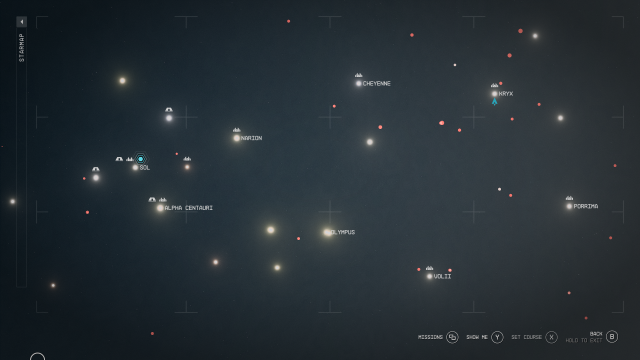
But not all planets are made equal. There are four different types: planets made of gas, liquids, barren planets, and planets with alien life or smatterings of humans and populated planets. No matter what planet you land on, the visuals are gorgeous.
If you can land on a planet, there are guaranteed to be several resources and at least two points of interest. If there’s a colony or research outpost, there’s a chance there’ll even be side quests or loot to find.
But the most interesting planets have cities. Initially, I thought there were only four cities: New Atlantis, Cydonia, Neon, and Akila City. You’ll encounter these cities multiple times as you complete the main plot and side quests, and they each have their own distinct aesthetic. New Atlantis is a utopian Earth, Cydonia is your industrial miner town, Neon takes its queues from gritty cyberpunk, and Akila City is the Old West.
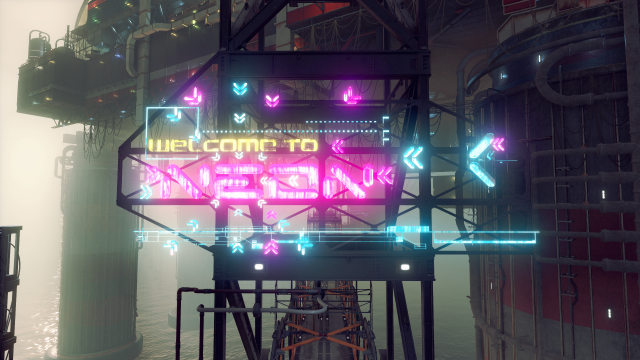
And for days, I was disappointed by how few major settlements there were. It was only after the 70+ hour mark that, purely by chance, I overheard a conversation that put a new planet on my activity list. This planet was the home of a space resort, where I picked up a big side quest, which led to a new city on a new planet.
These smaller cities don’t have the depth of the main four, but finding them was one highlight of the game for me. There was no reason in my main quest to ever go to that resort planet. I could have played hundreds of hours and never stumbled across it. And that’s the beauty of the game. There are so many things to discover: new locales, new people, new side quests.
And by the Great Serpent, there are a lot of side quests.
My To-Do List is Ten Pages Long | Side Quests, Activities, and Bounties
I may have been less than impressed by Starfield’s opening act because I was immediately distracted by the half-dozen side quests and activities you get bombarded with when you enter free-roaming mode.
I have no idea how many quests and activities there are. Hundreds, perhaps. And they occur incredibly intuitively.
You can only obtain some side quests by speaking to characters (helpfully named, in a sea of people only called “Citizen”). Others are gained by overhearing conversations. And then still others turn into a huge chain of side quests, which only grow more ridiculous and over the top as you go.
For example, I’d help a random citizen hit their mining quota. And then, an hour later, I’m in the governor’s office, threatening to expose his dirty little secrets unless he’s got enough credits to corrupt my flimsy sense of intergalactic justice.
______
“I’d help a random citizen hit their mining quota. And then an hour later I’m in the governor’s office, threatening to expose his dirty little secrets unless he’s got enough credits to corrupt my flimsy sense of intergalactic justice.“
______
But from a gameplay level, these chain quests hit everything on my gameplay rubric. They offer world-building details about the location the quest is set in. The writing is good enough to immerse me in the local drama. And once a chain side quest is completed, there are changes in the environment. Your decisions affect the dialogue of the NPCs in the area, giving the impression that your choices matter.
Even better, each side quest, mission, and activity can be accomplished differently. I ran a persuade build, so through the gift of gab, all problems were solved. But if my persuasion checks failed, other options were always open for me. I could sneak, I could steal, I could knock down doors with guns a-blazin’. Or I could pay someone off.
But these side quests shine the brightest when they’re part of a faction storyline.
Leader in All Factions, Loyal to None | Factions
So, when I first started Starfield, I was very nervous about joining a Faction, thinking that it would mean I was permanently locked into a certain affiliation. This isn’t the case. You can join them all, and no one seems to care. And that’s great because Factions, hands down, have some of the best side quests and rewards in the game.
There are four factions in Starfield. There’s the Americore military united called the United Colonies, the Old West inspired Freestar Collective, the cutthroat corporation Ryujin Industries, and the much-reviled space pirates, the Crimson Fleet.
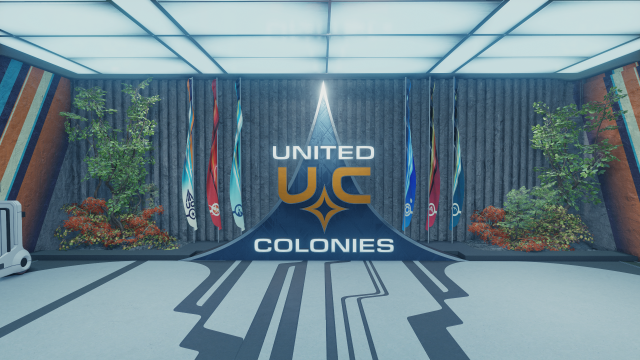
Each one offers a unique storyline, which suits the aesthetic of each faction. The United Colonies dives into military secrets. Ryujin Industries has you dabble in corporate espionage. The Crimson Fleet has you chasing after a legendary treasure.
And these storylines were the best way to get a cross section into the world building of Starfield. Not only do they showcase the distinct position of the faction in the galaxy, but they also shine a light on the other alliances and adversaries involved with that faction, and the current day politics that influence them.
These quests never wind up where you think they are. It’s always a wild ride, with excellent writing and a good cast of characters in each. Never mind a fantastic crescendo to wrap it all up in a neat little bow.
I Bought All My Best Friends | Companions in Battle and Love
I am a sucker for a good companion system. I just love collecting friends and storing them in my ship, so we can rove around space like a bad sitcom. And there are many, many potential companions to choose from.
As I played the game, I kept track of each companion I came across. When I started writing this review, I found 29, each with a diverse array of skills and varying degrees of expertise. I am positive there are more companions out there. Generally, you’ll have to pay for a companion to join your crew, but a generous handful will join your team for free.
Recruitable companions vary in character depth and writing. Some companions don’t even have names. They’ll be something like “Em Weapon Specialist.” And then, you’ll find a random companion in the worst bar in a Podunk city with a great voice actor and a rich back story. It’s the complete gamut, perfect for people who want more roleplay aspects or prefer to keep their ship and outposts optimized.
______
“And then, you’ll find a completely random companion in the worst bar in a Podunk city with a great voice actor and rich back story. It’s the complete gamut.”
______
Some companions can even reach the status of “allies,” which occurs when you romance them or make them your mega best friend. Doing so requires you to complete their side quest. And while the system is good, I found the execution fell just short of where I wanted it to be, with some redemption in the final interaction.
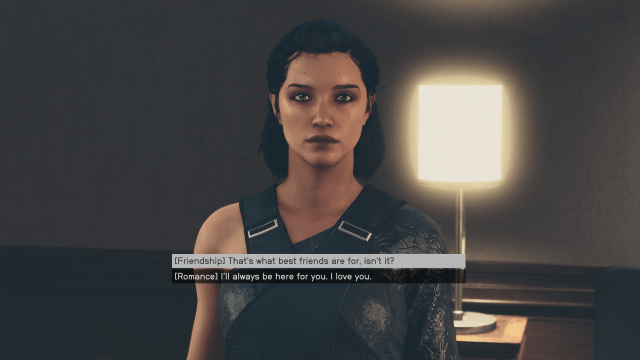
I opted very early on to romance Andrea. From the moment I unlocked her to the end of the game, she was in my party. I made decisions based on her personality to accelerate our budding romance. But that relationship grew very slowly. Andrea often interjected when I was conversing with other NPCs, especially when a choice needed to be made on the planets and cities we encountered. These interjections were the primary way I got a sense of her personality, and I enjoyed them when they occurred.
And while her quest was good, it offered me more sense of her backstory; it didn’t feel like it involved me. I felt like a passive observer in her character arc, even if she periodically referenced something I’d said before. The situation could have been improved with the ability to have more in-depth conversation options, a chance to bring her to the restaurant she mentioned she liked, and an option to give her gifts. To be more involved in general.
That being said, the companion system is at its peak when you reach the commitment stage.
Commitment is, essentially, marriage to the companion of your choice. Your companion will invite you to a specific location, and you’ll get a very touching interaction with them, followed by a keepsake. It’s a one-time event, but the writing for Andrea shined in this moment.
Previously, my feelings towards Andrea were a middling fondness. I appreciate her strong sense of justice, social awkwardness, and neurodivergent flair. But the commitment scene made me genuinely like her. And after you reach commitment, your companion becomes aggressively more affectionate toward you. I’ve been called dearest, darling, and love dozens of times, and I never get sick of it. And now she smiles at me when I talk to her, and you share the same bed when you sleep.
But committing to a character also means you’re barred from starting a relationship with another. At least, that’s the case for Andrea.
All the Places We Call Home | Houses, Outposts, Ships
You can go the entire game without ever getting a house, building an outpost, or upgrading your ship. But doing so is a mistake. There’s an entire world of customization in Starfield that gives its gameplay and roleplaying nuance.
For example, houses. You can buy a shipping crate to live in and take residence in the shadiest slum in the galaxy. Or you can grab your own penthouse suite on top of the most popular nightclub. Once you have a house, you can decorate it to your heart’s content, with more furniture and decorations becoming available as you research how to make them.
I immediately created a display cabinet for all the stolen space plushies I found.
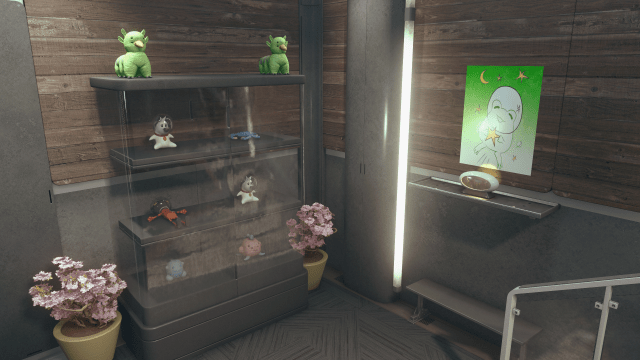
Outposts are hybrid beasts. You can technically just slap an Outpost on any planet with resources to mine. And if the right equipment is there, you’ll slowly accrue the resource of your choice. But you can also craft a beautiful hub with all the furniture you can have in your house. And, even better, you can station companions there, giving the location a curated colony/space settler vibe. You’re making your mark on the galaxy in some small way, even if it’s just to mine aluminum and copper.
______
“You’re making your mark on the galaxy in some small way, even if it’s just to mine aluminum and copper.”
______
Finally, ships. You’re going to spend a significant amount of time on your ship. And while I’m not a huge fan of vehicle-based combat, you can purchase new ships, customize them to a degree, and upgrade their ability to survive in battle. You can have a fleet of ships, and some of the ships you can buy are ridiculous. My favorite, of course, is the Spacetruk, which lets you haul more ore than you can shake a shotgun at. It’s also massive.
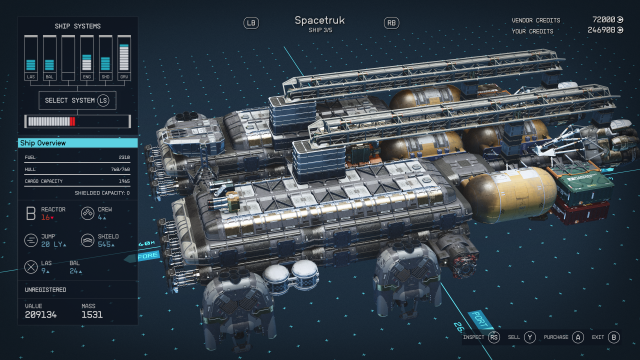
Now, let me return to space combat. Visually and conceptually, it’s fantastic. It adds a new dimension to the game, and it’s realistic, considering the wide variety of people and organizations you meet. But I never once enjoyed a space dog fight. When you first get your ship, the controls are clunky, the ship moves slowly, and the rate of fire is pitiful.
You can slowly upgrade skills related to ship combat and, as mentioned, you can upgrade your ship’s weapons and shields. And while this makes the controls easier and the entire aspect more tolerable, the painful process of slowly turning my ship to get a lock on my enemy was always more tedious than fun. It’s even worse if you’re fighting multiple ships at once.
But space battles aren’t the game’s only awkward and clumsy moments.
There’s Something Great Beyond These Menus | Early to Mid-Game Experience
Learning how to play Starfield is a quest in and of itself. Very early, you’ll be greeted with a nesting doll of menus called the “Star Maps.” Initially, I found using these maps to be incomprehensible. Setting course, grav jumping, and scanning were areas of mystery.
Two weeks later, I found them easy to use. When starting a new game, I can immediately navigate to whatever system I want, with little effort, which speaks to just how open world Starfield really is. But the Star Menus aren’t the only place players will likely have trouble. Outpost management and workshops are places where things can seem complicated and opaque until you dedicate the time to tinkering and learning them.
My struggles with the early game perfectly reflect my experience with Starfield as a whole. It’s a slow, almost awkward start. But it only gets better as it goes. Once I hit mid-game, I could carry a significant number of resources, which meant I had a nice influx of Credits (space money). Having a nice nest egg of Credits meant I could focus on research and customizing my many penthouses.
This research allowed me to upgrade my weapons, my space suit, and my ship. Which meant I felt freer to explore the galaxy. This led me to discover dozens upon dozens of new quests, meet new companions, and have a tremendous space-faring time.
And you can opt to do it all again with a New Game+. Unfortunately, Embargo prevents me from delving into the details of New Game+. But it’s a seamless transition and perhaps one of the most satisfying ways to start a New Game I’ve ever seen.
But not everything in Starfield is star shine.
There’s No Gossip in Space | Immersion Breakers
As much as I’ve loved Starfield, a few issues ripped me out of the experience. And while these issues were small, they built into a larger feeling of loneliness.
The first issue, and the one that bothered me the most, was the lack of small talk in cities at the start of the game. It was strange to walk through congested corridors and well-populated plazas and hear… nothing. Periodically, there’d be a conversation, but it’d be the same dialogue repeated in the same area. I would have sold someone’s kidney to have a radio with beats for the space age Starfield is set in. A chance to dial into the Astral Lounge’s station would have been extraordinary.
Next, there’s the repetition. With so many planets to explore, it’s only natural that you’ll run into the same tiles. The same points of interest. The same grunts that you’ve killed half a dozen times before. But these tiles are identical, from the enemy placement to the loot within. I would have been happier if the building was the same, but some items were moved around.
Continuing with planets, I really wish there was a way to “favorite” planets. While planetary fast travel is one of Starfield’s developers’ best decisions, remembering where that random city that sells SpaceTruks is is not fun. There are too many systems that it could be in.
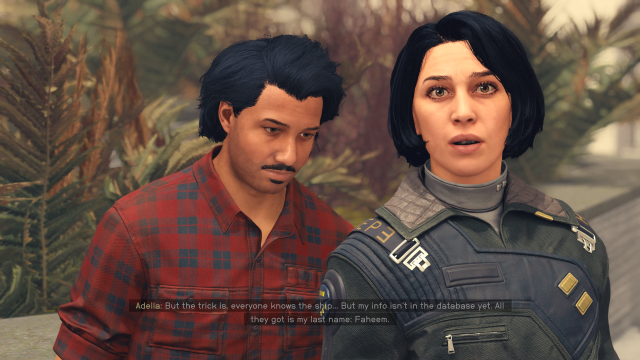
Finally, the only real “bug” in the game is the NPC collision. NPCs, especially in places like Neon, clog thoroughfares. Shouldering past them is extremely difficult, and the way I’ve found to get through them is by using my boostpack to float over them. But sometimes NPCs can’t be interacted with if they’re sitting. Other times, NPCs will push aggressively into each other, especially if you happen to be talking to one.
But for every hiccup, there are a dozen quality-of-life features, Easter eggs, and details.
A Love Letter to the Little Things | Quality of Life and Details
Starfield is built around the long haul. It succeeds in this not only with its flexibility but in the little details that are built into the game.
I mentioned earlier how eerily quiet the cities are at the start of the game. On the other hand, when people in cities talk, it’s because they have a piece of juicy gossip that will lead to a quest. I love this intuitive way of getting activities.
And then, there are the random encounters. As you traverse the galaxy in your ship, there’s a chance that you’ll come across a captain singing a sea shanty. He offers nothing but his song; there’s no quest, no trade to be made. But it was nice. It was one of those special moments.
Next comes the detail of sounds. You’ll get a unique sound effect if you pick up certain items. There’s a space plush line that squeaks when you pick them. If you find and loot a Newton’s Cradle, you’ll get that satisfying click-click-click of the silver balls hitting each other.
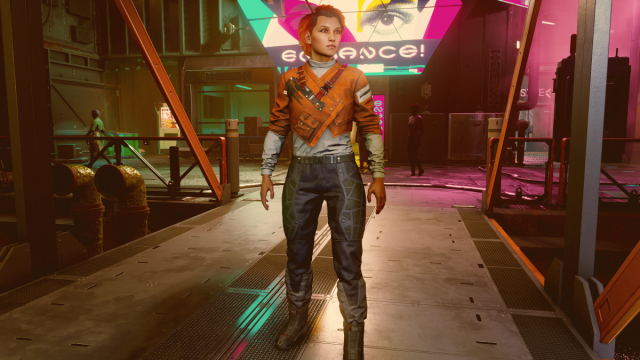
Then there’s the sheer convenience that Starfield has built into it. If you hate how your character looks, you can change their appearance any time for a small fee at a clinic. If you need resources, you’re almost guaranteed to have a general shop in the nearest big city that sells it. If you’ve picked up a few stolen or illicit goods, the Trade Union is pleased to take them off your hands, and they’re easy to find.
You can land your ship anywhere on a planet, so long as it’s solid. You can fast travel to any planet you’ve discovered or to any point of interest you’ve found. Almost every problem (including many quests), can be solved by throwing money at it. Scanning an alien or plant enough times will tell you precisely what resources you can get from harvesting it, and if you can harvest it, you can build an outpost dedicated to getting more of it.
This is a long list. It could be even longer. There are so many ways that Starfield has made playing the game a stress-free affair.
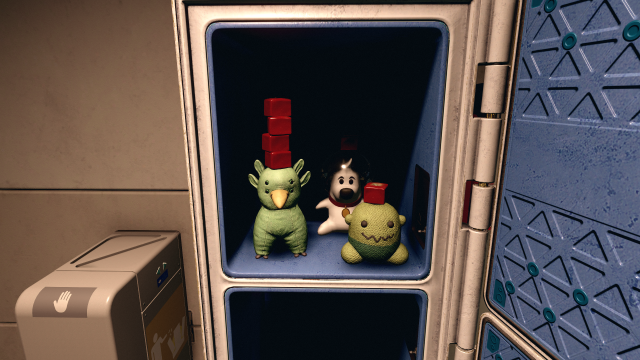
Exploring every nook and cranny will also lead you to discovering things both practical and not. For example, a locked safe might have its key stashed on a shelf nearby. You might open a locker and find a silly little display… or find someone’s dark secret. So much attention to detail has been poured into the most random places, and there is always a reward for exploring.
Usually, that reward is a valuable gun, a space suit, or a lot of cash. But sometimes, it’s narrative-driven.
Dear Todd Howard… | Conclusion
Here’s the final verdict. Starfield is a good game, like a really good game. It embodies the spirit of Manifest Destiny in a way that no other open-world game has ever come close to approaching. It’s a game that’s meant to be played slowly over the course of months, if not years. And even then, you shouldn’t expect to uncover every little detail.
But beyond the sheer scope of it, it offers everything you could ever want from an RPG. Stunning visuals, well-written, and realistic (or absolutely ridiculous) side quests. A small village’s worth of companions to get to know, befriend, and woo. There are plenty of houses to purchase or earn, which can be customized to your liking—dozens upon dozens of weapons and spacesuits can be tweaked to your preferred playstyle.
It’s the RPG I was desperately hoping Bethesda would make. And once I’m done writing this review, I’m going to go right back to playing it.

- An entire galaxy to explore.
- Dozens of well-written side quests with multiple ways to complete each one.
- A game that gets better, and more nuanced, the longer you play.
- Menus and user interfaces can feel unintuitive.
- Cities can feel lifeless.
- The main story doesn't gain traction until act 3.





Published: Aug 31, 2023 12:00 pm